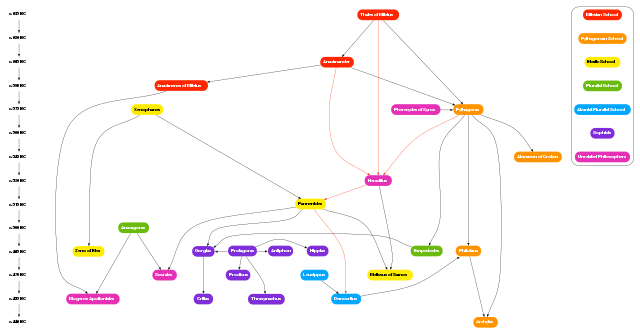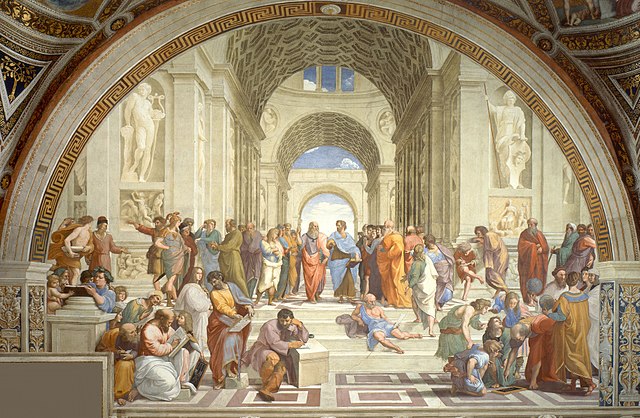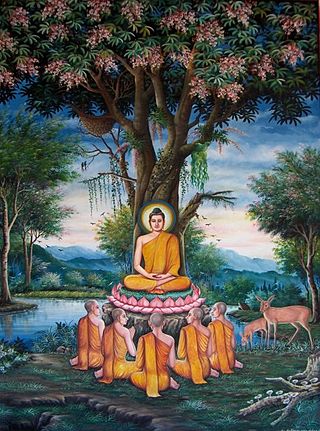یہ صفحہ قدیم فلسفے کے کچھ روابط کی فہرست ہے۔ مغربی فلسفے میں، رومی سلطنت میں مسیحیت کے پھیلاؤ نے ہیلینیائی فلسفے پر خاتمے کی مہر لگا دی اور فلسفہ قرون وسطی کا آغاز ہوا، جبکہ مشرقی فلسفے میں، اسلام کے پھیلاؤ نے قدیم ایرانی فلسفے کا خاتمہ کر دیا اور ابتدائی اسلامی فلسفے کا آغاز ہوا۔
خالص فلسفیانہ سوچ، خلقی انفرادی بصیرت پر منحصر ہے، اس کا آغاز بہت سی ثقافتوں میں تقریباً اتفاقی طور پر ہوا۔
فلسفی
- تاؤ مت
- لاؤزی (پانچویں–چوتھی صدی قبل مسیح)
- Zhuangzi (چوتھی صدی قبل مسیح)
- Zhang Daoling
- Zhang Jue (وفات 184 عیسوی)
- Ge Hong (283 – 343 عیسوی)
- کنفیوشس مت
- Legalism
- Li Si
- Li Kui
- Han Fei
- Mi Su Yu
- Shang Yang
- Shen Buhai
- Shen Dao
- مؤیت
- موزی
- Song Xing
- Logicians
- Deng Xi
- Hui Shi (380–305 قبل مسیح)
- Gongsun Long (c. 325 – c. 250 قبل مسیح)
- Agrarianism
- Xu Xing
- Naturalism
- Zou Yan (305 – 240 قبل مسیح)
- Neotaoism
- Wang Bi
- Guo Xiang
- Xiang Xiu
- School of Diplomacy
- Guiguzi
- Su Qin (380 – 284 قبل مسیح)
- Zhang Yi (bef. 329 – 309 قبل مسیح)
- Yue Yi
- Li Yiji (268 – 204 قبل مسیح)
- School of the Military
- Sunzi (c. 500 قبل مسیح)
- Sun Bin (وفات 316 قبل مسیح)


فلسفی
ماقبل سقراطی فلسفی
- Milesian School
- تھالیز (624 – c 546 قبل مسیح)
- اناکسی میندر (610 – 546 قبل مسیح)
- اناکسی مینس (c. 585 – c. 525 قبل مسیح)
- فیثا غورثی
- فیثاغورث (582 – 496 قبل مسیح)
- فلولاؤس (470 – 380 قبل مسیح)
- Alcmaeon of Croton
- آرکیٹاس (428 – 347 قبل مسیح)
- ہیروکلیطس (535 – 475 قبل مسیح)
- Eleatic School
- Xenophanes (570 – 470 قبل مسیح)
- بارامانیاس (510 – 440 قبل مسیح)
- Zeno of Elea (490 – 430 قبل مسیح)
- Melissus of Samos (c. 470 قبل مسیح – ?)
- Pluralists
- امپی دوکلیز (490 – 430 قبل مسیح)
- اناکسا غورث (500 – 428 قبل مسیح)
- Atomists
- Leucippus (first half of پانچویں صدی قبل مسیح)
- دیموقراطیس (460 – 370 قبل مسیح)
- Metrodorus of Chios (چوتھی صدی قبل مسیح)
- Pherecydes of Syros (6th صدی قبل مسیح)
- Sophists
- پروتاغوراث (490 – 420 قبل مسیح)
- Gorgias (487 – 376 قبل مسیح)
- Antiphon (480 – 411 قبل مسیح)
- Prodicus (465/450 – بعد از 399 قبل مسیح)
- Hippias (وسط پانچویں صدی قبل مسیح)
- Thrasymachus (459 – 400 قبل مسیح)
- Callicles
- Critias
- Lycophron
- Diogenes of Apollonia (c. 460 قبل مسیح – ?)
قدیم یونانی فلسفی
- سقراط (469 – 399 قبل مسیح)
- Euclid of Megara (450 – 380 قبل مسیح)
- اینٹی شینز (445 – 360 قبل مسیح)
- ارسطیفوس (435 – 356 قبل مسیح)
- افلاطون (428 – 347 قبل مسیح)
- Speusippus (407 – 339 قبل مسیح)
- دیو جانس کلبی (400 – 325 قبل مسیح)
- Xenocrates (396 – 314 قبل مسیح)
- ارسطو (384 – 322 قبل مسیح)
- Stilpo (380 – 300 قبل مسیح)
- Theophrastus (370 – 288 قبل مسیح)
ہیلینیائی فلسفی
- Pyrrho (365 – 275 قبل مسیح)
- Epicurus (341 – 270 قبل مسیح)
- Metrodorus of Lampsacus (the younger) (331 – 278 قبل مسیح)
- Zeno of Citium (333 – 263 قبل مسیح)
- Cleanthes (c. 330 – c. 230 قبل مسیح)
- Timon (320 – 230 قبل مسیح)
- Arcesilaus (316 – 232 قبل مسیح)
- Menippus (3rd صدی قبل مسیح)
- ارشمیدس (c. 287 – 212 قبل مسیح)
- Chrysippus (280 – 207 قبل مسیح)
- Carneades (214 – 129 قبل مسیح)
- Clitomachus (187 – 109 قبل مسیح)
- Metrodorus of Stratonicea (late 2nd صدی قبل مسیح)
- Philo of Larissa (160 – 80 قبل مسیح)
- Posidonius (135 – 51 قبل مسیح)
- Antiochus of Ascalon (130 – 68 قبل مسیح)
- Aenesidemus (1st صدی قبل مسیح)
- Agrippa (1st صدی عیسوی)
ہیلینیائی مکتب فکر
- Cynicism
- Eclecticism
- ایپی قوریت
- Middle Platonism
- نو افلاطونیت
- Neopythagoreanism
- مشائیت
- Pyrrhonism
- رواقیت
- Sophism
Early Roman and Christian philosophy
- School of the Sextii
Philosophers during Roman times

- سائیسیرو (106 – 43 قبل مسیح)
- Lucretius (94 – 55 قبل مسیح)
- Seneca (4 قبل مسیح – 65 عیسوی)
- Musonius Rufus (30 – 100 عیسوی)
- پلو ٹارک (45 – 120 عیسوی)
- Epictetus (55 – 135 عیسوی)
- Marcus Aurelius (121 – 180 عیسوی)
- کلیمینس اسکندری (150 – 215 عیسوی)
- Alcinous (philosopher) (2nd صدی عیسوی)
- Sextus Empiricus (3rd صدی عیسوی)
- Alexander of Aphrodisias (3rd صدی عیسوی)
- Ammonius Saccas (3rd صدی عیسوی)
- Plotinus (205 – 270 عیسوی)
- Porphyry (232 – 304 عیسوی)
- Iamblichus (242 – 327 عیسوی)
- Themistius (317 – 388 عیسوی)
- سینٹ آگسٹائن (354 – 430 عیسوی)
- Proclus (411 – 485 عیسوی)
- Damascius (462 – 540 عیسوی)
- Boethius (472 – 524 عیسوی)
- Simplicius of Cilicia (490 – 560 عیسوی)
- John Philoponus (490 – 570 عیسوی)
The ancient Indian philosophy is a fusion of two ancient traditions : Sramana tradition and Vedic tradition.
Vedic philosophy
Indian philosophy begins with the وید where questions related to laws of nature, the origin of the universe and the place of man in it are asked. In the famous رگ وید Hymn of Creation (Nasadiya Sukta) the poet says:
- "Whence all creation had its origin,
- he, whether he fashioned it or whether he did not,
- he, who surveys it all from highest heaven,
- he knows—or maybe even he does not know."
In the تاریخی ویدک مذہب view, creation is ascribed to the self-consciousness of the primeval being (Purusha)۔ This leads to the inquiry into the one being that underlies the diversity of empirical phenomena and the origin of all things. Cosmic order is termed rta and causal law by karma۔ Nature (prakriti) is taken to have three qualities (sattva، rajas، and tamas)۔
Sramana philosophy
جین مت and بدھ مت are continuation of the Sramana school of thought. The Sramanas cultivated a pessimistic worldview of the samsara as full of suffering and advocated renunciation and austerities. They laid stress on philosophical concepts like Ahimsa, Karma, Jnana, Samsara and Moksa. Cārvāka (Sanskrit: चार्वाक) (atheist) philosophy, also known as Lokāyata, it is a system of Hindu philosophy that assumes various forms of philosophical skepticism and religious indifference. It is named بعد از its founder, Cārvāka, author of the Bārhaspatya-sūtras.
Classical Indian philosophy
In classical times, these inquiries were systematized in six schools of philosophy. Some of the questions asked were:
- What is the ontological nature of consciousness?
- How is cognition itself experienced?
- Is mind (chit) intentional or not?
- Does cognition have its own structure?
The Six schools of ہندوستانی فلسفہ are:
- Nyaya
- Vaisheshika
- Samkhya
- Yoga
- Mimamsa (Purva Mimamsa)
- ویدانت (Uttara Mimamsa)
Ancient Indian philosophers
1st millennium قبل مسیح
- Parashara — writer of Viṣṇu Purāṇa۔
Philosophers of Vedic Age (2000–600 قبل مسیح)
- Rishi Narayana — seer of the Purusha Sukta of the رگ وید۔[1]
- سات رشی — Atri, Bharadwaja, Gautama, Jamadagni, Kasyapa, Vasishtha, Viswamitra.[2]
- رشی — Gritsamada, Sandilya, Kanva etc.
- رشبھ ناتھ — رشی mentioned in رگ وید and later in several Puranas, and believed by Jains to be the first official religious گرو of جین مت، as accredited by later followers.
- Yajnavalkya — one of the وید sages, greatly influenced بدھ مت thought.
- انگیار — one of the seers of the اتھرو وید and author of Mundaka Upanishad۔
- Uddalaka Aruni — an Upanishadic sage who authored major portions of Chāndogya Upaniṣad۔
- Ashvapati — a King in the مہا جن پد who authored Vaishvanara Vidya of Chāndogya Upaniṣad۔
- Ashtavakra — an Upanishadic Sage mentioned in the مہا بھارت، who authored Ashtavakra Gita۔
Philosophers of Axial Age (600–185 قبل مسیح)
- Kanada (c. 600 قبل مسیح)، founded the philosophical school of Vaisheshika، gave theory of atomism
- مہاویر (599–527 قبل مسیح) — heavily influenced جین مت، the 2چوتھی تیرتھنکر of جین مت۔

- پانینی (520–460 قبل مسیح)، grammarian, author of پانینی
- کپل (c. 500 قبل مسیح)، proponent of the Samkhya system of philosophy.
- Badarayana (lived between 500 قبل مسیح and 400 قبل مسیح) — Author of Brahma Sutras۔
- Pingala (c. 500 قبل مسیح)، author of the Chandas shastra
- گوتم بدھ (c. 480 – c. 400 قبل مسیح)، founder of بدھ مت school of thought
- چانکیہ (c. 350 – c. 275 قبل مسیح)، author of ارتھ شاستر، professor (acharya) of political science at the ٹیکسلا
- Patañjali (c. 200 قبل مسیح)، developed the philosophy of Raja Yoga in his Yoga Sutras.
- Shvetashvatara — Author of earliest textual exposition of a systematic philosophy of شیو مت۔
Philosophers of Golden Age (184 قبل مسیح – 600 عیسوی)
- Gotama (c. 2nd–3rd صدی عیسوی)، wrote Jaimini، author of Purva Mimamsa Sutras۔
- Dignāga (c. 500)، one of the founders of Buddhist school of Indian logic۔
- Asanga (c. 300)، exponent of the Yogacara
- بھرتری ہری (c 450–510 عیسوی)، early figure in Indic linguistic theory
- بودھی دھرم (c. 440–528 عیسوی)، founder of the زین بدھ school of بدھ مت
- Siddhasena Divākara (پانچویں Century عیسوی)، Jain logician and author of important works in Sanskrit and Prakrit, such as, Nyāyāvatāra (on Logic) and Sanmatisūtra (dealing with the seven Jaina standpoints, knowledge and the objects of knowledge)
- وسوبندھو (c. 300 عیسوی)، one of the main founders of the Indian Yogacara school.
- Kundakunda (2nd Century عیسوی)، exponent of Jain mysticism and Jain nayas dealing with the nature of the soul and its contamination by matter, author of Pañcāstikāyasāra (Essence of the Five Existents)، the Pravacanasāra (Essence of the Scripture) and the Samayasāra (Essence of the Doctrine)
- ناگ ارجن (c. 150 – 250 عیسوی)، the founder of the Madhyamaka (Middle Path) school of مہایان۔
- Umāsvāti or Umasvami (2nd Century عیسوی)، author of first Jain work in Sanskrit, Tattvārthasūtra، expounding the Jain philosophy in a most systematized form acceptable to all sects of Jainism.

See also: ثنویت، Dualism (philosophy of mind)
While there are ancient relations between the Indian وید and the Iranian اوستا، the two main families of the Indo-Iranian philosophical traditions were characterized by fundamental differences in their implications for the human being's position in society and their view of man's role in the universe. The first charter of انسانی حقوق by کورش اعظم as understood in the اسطوانۂ کورش is often seen as a reflection of the questions and thoughts expressed by زرطشت and developed in زرتشتیت schools of thought of the ہخامنشی سلطنت of تاریخ ایران۔[3][4]
Schools of thought
Ideas and tenets of Zoroastrian schools of Early Persian philosophy are part of many works written in Middle Persian and of the extant scriptures of the zoroastrian religion in اوستائی زبان۔ Among these are treatises such as the Shikand-gumanic Vichar by Mardan-Farrux Ohrmazddadan, selections of Denkard، Wizidagīhā-ī Zātspram ("Selections of Zātspram") as well as older passages of the book Avesta, the Gathas which are attributed to Zarathustra himself and regarded as his "direct teachings"۔[5]
Zoroastrianism
- زرطشت
- Jamasp
- Ostanes
- Mardan-Farrux Ohrmazddadan[6]
- Adurfarnbag Farroxzadan[7]
- Adurbad Emedan[7]
- اوستا
- Gathas
Anacharsis
Pre-Manichaean thought
Manichaeism
Mazdakism
Zurvanism
- Aesthetic Zurvanism
- Materialist Zurvanism
- Fatalistic Zurvanism
Philosophy and the Empire
- Political philosophy
- Tansar
- اکادمی جندیشاپور
- Borzouye
- بختیشوع
- خسرو اول خسرو اول
- Paul the Persian
Literature
- پہلوی ادب
First Temple (c. 900 قبل مسیح to 587 قبل مسیح)
Assyrian exile (587 قبل مسیح to 516 قبل مسیح)
- کتاب یسعیاہ (6th صدی قبل مسیح)
- حجی (6th صدی قبل مسیح)
- عبدیاہ (6th صدی قبل مسیح)
- کتاب یسعیاہ (6th صدی قبل مسیح)
- زکریا بن برخیا (6th صدی قبل مسیح)
Second Temple (516 قبل مسیح to 70 عیسوی)
Early Roman exile (70 عیسوی to c. 600 عیسوی)
- Rabbi Akiva (c. 40 – c. 137 عیسوی)
- Index of ancient philosophy articles
Wikiwand in your browser!
Seamless Wikipedia browsing. On steroids.
Every time you click a link to Wikipedia, Wiktionary or Wikiquote in your browser's search results, it will show the modern Wikiwand interface.
Wikiwand extension is a five stars, simple, with minimum permission required to keep your browsing private, safe and transparent.